Online. By at least a factor of two.
Our recent article entitled Lessons learnt from organizing a virtual conference discusses some of our technology choices and how we leveraged them to put on a successful online meeting. That article touches briefly on some of the challenges we faced, but it doesn’t fully convey how much work it was–both in advance and during the event.
Before we go any further, who are you? This post was written by Nomi Harris, the long-time (co-)chair of BOSC, and the co-chair (along with Dave Clements) of BCC2020 (the Bioinformatics Community Conference, a collaboration between the Bioinformatics Open Source Conference (BOSC) and the Galaxy Community Conference (GCC)). The perspective expressed in this post is mine alone, and does not necessarily reflect the views of others on the BCC2020 organizing committee. Also, although BCC2020 was an equal partnership between BOSC and GCC and the planning was done jointly (except for abstract reviews), my perspective is naturally BOSC-centric.
 Me, with a fake bookshelf backdrop and a pear facemask. (The BCC2020 sign only appeared backwards to me, not to the viewers.)
Me, with a fake bookshelf backdrop and a pear facemask. (The BCC2020 sign only appeared backwards to me, not to the viewers.)
What was the original plan for BCC2020, and wha t changed? BCC2020 was originally going to take place in Toronto. The organizing committee made the decision in March to move it online, and it became increasingly clear with every day that passed that there was no way we could have held the conference in person in Toronto as originally planned.
 The original BCC home page showed the Toronto skyline at night.
The original BCC home page showed the Toronto skyline at night.
Who runs these meetings, anyw ay? One thing to understand about BCC2020 is that aside from a few Galaxy people for whom planning conferences is part (a small part) of their job, all the organizers are volunteers. We have regular jobs, and we work on conference organization during our evenings and weekends.
 The BCC2020 organizing committee
The BCC2020 organizing committee
Many of us on the BCC2020 organizing committee have been involved in BOSC or GCC organization for years. (I, for example, was involved in planning the very first BOSC in 2000, started co-chairing it in 2010, and have chaired or co-chaired it every year since then.) So we are pretty used to doing the huge amount of work involved in planning an in-person BOSC. None of us had ever organized a large online meeting before, so there was a big learning curve. Our recent article entitled Lessons learnt from organizing a virtual conference discusses some of our technology choices and how we leveraged them to put on a successful online meeting. That article touches briefly on some of the challenges we faced, but it doesn’t fully convey how much work it was–both in advance and during the event.
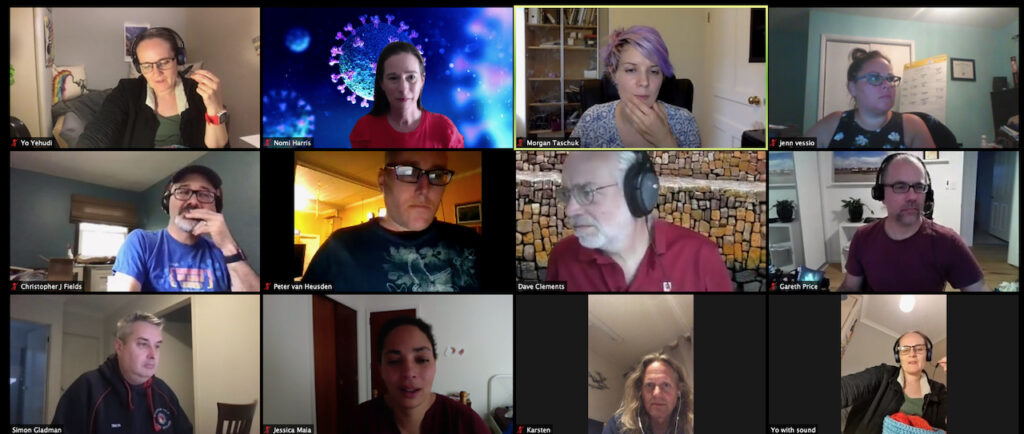 The organizing committee met almost every week during the spring and summer.
The organizing committee met almost every week during the spring and summer.
There must be things that are easier with an online m eeting , right? Yes, a few, but not a lot. There’s no travel required for an online meeting, so there’s no need to book plane tickets or research hotels–but that’s true for everyone who participates in a meeting, not just the organizers. As meeting organizers, we don’t plan travel for anyone other than ourselves, so that doesn’t really count towards lightening our organization duties. We didn’t have to worry about handing out name tags or T-shirts, but those tasks are also not the direct responsibility of the organizing committee. An online meeting doesn’t involve food or coffee–but the volunteer organizing committee doesn’t generally have to do any planning for those; they are handled by the venue. So are the projector, wifi, air conditioning, the chairs in the conference rooms, etc. Basically, only if we for some reason decided to hold our conference in an empty warehouse would the organizational overhead come close to the difficulty level of planning an online meeting.
Why was organizing an online meeting so hard?
This was our first online meeting. We’d never done this before, so we had to figure out a lot of things. It almost certainly wouldn’t be quite this hard to organize another online meeting next year, particularly if we stick with the same technology choices. Karsten postulates that online conferences probably have a higher “reusability factor” than in-person ones, from a planning perspective.
More options to consider. For an in-person meeting, many of the choices and the responsibility for supporting those choices fall on the venue. For example, there are many different kinds of video projectors. Some are better than others. Some are more expensive than others. Which one should we choose for our meeting? Fortunately, we never had to make that choice: the venue has whatever projectors they have. With an online meeting, we not only had to (metaphorically) choose a projector, we had to set it up and run it ourselves. And the projector was only part of the story: we had to make choices and configure and support a variety of tech platforms that would not be required at an in-person meeting (such as a chat app).
We were early adopters. Admittedly, we made our job harder by choosing a video conferencing platform (Remo.co) that was new to us and to our attendees. Some things would have been simpler if we’d just run the meeting as a bunch of separate Zoom rooms. We wouldn’t have had to do as much training (of the organizers, the workshop leaders, the speakers, and the many volunteers), nor would we have had to write as much documentation. We wouldn’t have had to design floor plans for each of our virtual “buildings” (though actually Karsten Hokamp, who is a total hero, did all of that, as well as preparing most of the documentation and leading most of the training sessions. Seriously, he deserves to be knighted or something.)
The fact that Remo was new and still in active development led to some issues (for example, shortly before the conference, their system for registering attendees broke; at another point, private messaging stopped working). But overall, despite the challenges, we felt (and most of the participants agreed) that Remo offered an online conference experience that was more fun and more reminiscent of an in-person meeting. The reasons why we chose Remo, and the challenges and opportunities it presented, are covered in more detail in the article mentioned earlier ( Lessons learnt from organizing a virtual conference),
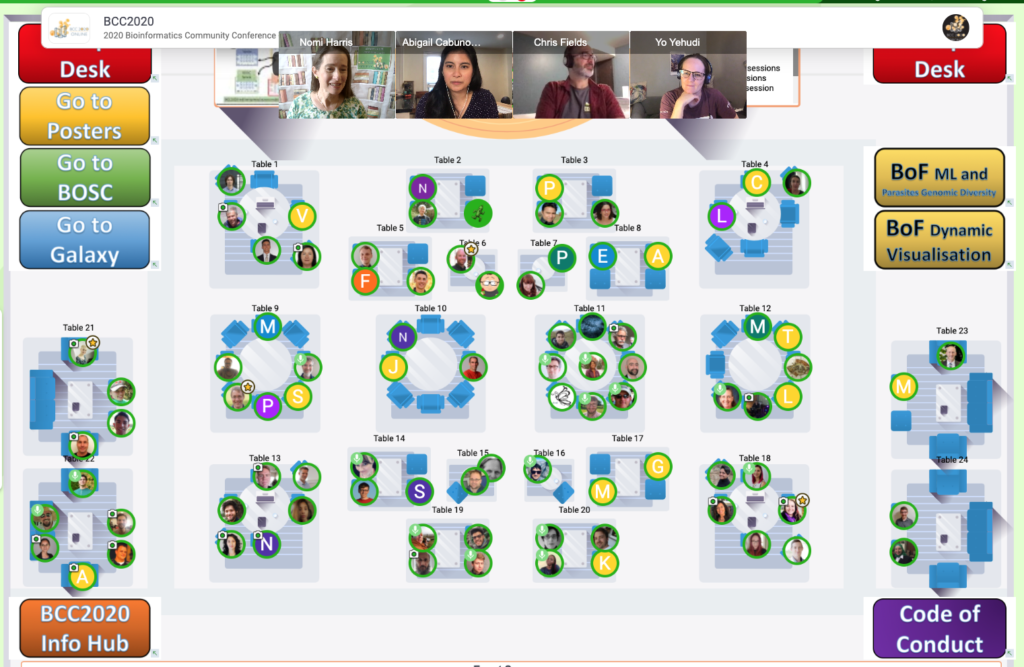 Chatting at one of the “tables” in Remo.
Chatting at one of the “tables” in Remo.
Tangent: serendipity at online meetings–it happens. While I’m on that subject, let me share an anecdote that didn’t make it into the “lessons learnt” post. One evening during the conference, I needed to talk to Dave Clements, but I wasn’t sure where he was. He wasn’t answering email or responding in Discord. But as I wandered through our virtual buildings, I happened to spot him in the poster building. He was at one of the sponsor tables, chatting with someone there (I could tell that they were talking because of the little microphone icons on their photos). I could choose to approach the table and break in on their conversation, or wait until they were done. It was uncannily similar to wandering through a conference center and serendipitously seeing someone you knew.
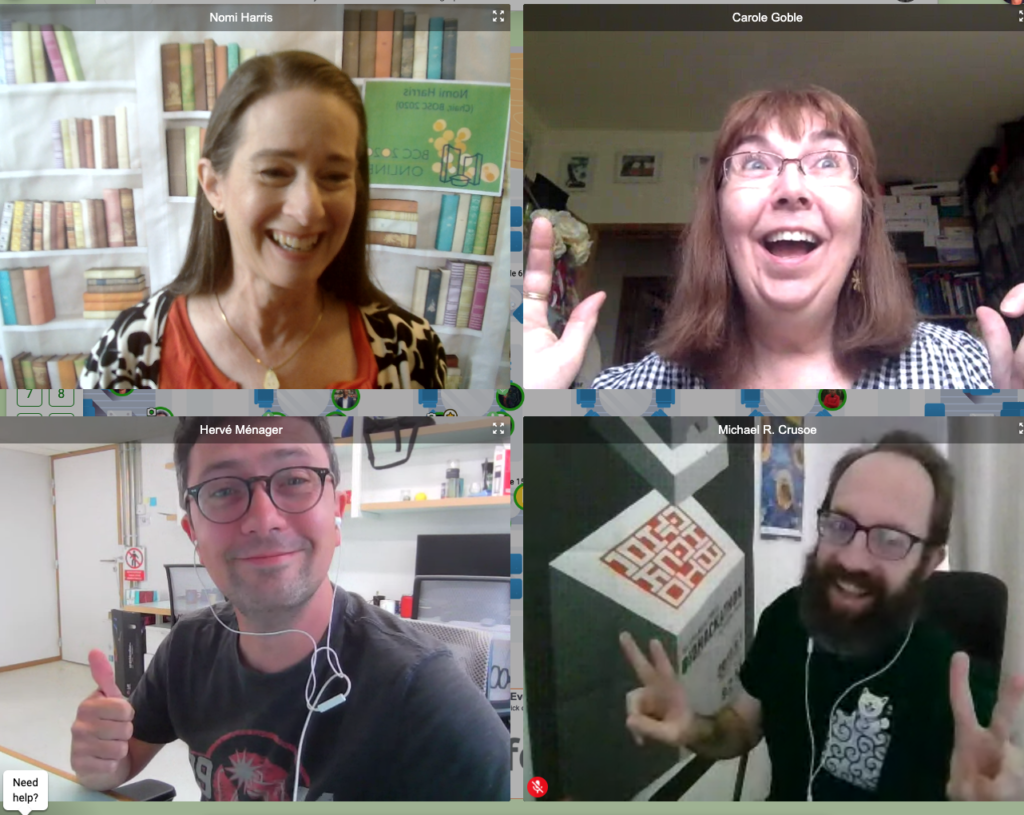 I ran into some old friends at the pre-meeting open house.
I ran into some old friends at the pre-meeting open house.
How do you walk and talk at a virtual meeting? That story might give you a sense of one reason running an online conference is hard: you have to come up with substitutes for things that you get for free in real life, like walking around a conference center and using your voice to talk to people. We couldn’t find a single technology platform that supported threaded, persistent chat in addition to video conferencing, so we ended up using Discord as well as Remo.
Online talks: what could possibly go wro ng? Another big challenge was how to present the talks. At an in-person meeting, the speakers just show up and talk. We realized pretty quickly that it would be way too risky to have all the speakers give their talks live during our online meeting. So many things could go wrong. They could get confused about the time zone and fail to show up. Their internet connection could be spotty, or could fail completely. Their computer could decide to reboot in the middle of their talk. Their toddler could toddle into the room and yank their headset off their head (this happens regularly to one of our organizing committee members). Things can and do go wrong at in-person talks, too (the video projector not working is a popular one), but online talks present a whole new array of possible fails.
We decided to have presenters pre-record their talks and share the videos with us. Actually, I have to admit that I was pretty sure that at least a few presenters would fail to get their videos done on time (or at all), but we had amazingly high compliance, and only a few speakers who brazenly went over their allotted time. We had to check all the videos to make sure the volume was ok (sometimes it wasn’t) and that the beginning and end of the video wasn’t truncated (sometimes it was). We then had to upload all the videos to a site from which they could be streamed–we chose Vimeo rather than YouTube because YouTube’s terms of service don’t allow you to stream videos for an audience. That was a lot of work, but once again, Karsten did it. (Is he a saint or WHAT?) We also added the video links to the online schedule, so that attendees could watch them asynchronously if they wanted to, which was a nice thing to do but again involved more work.
During the talk sessions, the session techs had to start each talk video at the appropriate time. We discovered as the meeting proceeded that different latencies in attendees’ internet connections meant that for some people, the video took longer to play, and therefore when the next talk started, they hadn’t yet finished watching the last one. This was one of a number of challenges we faced with the talk video presentations.
Working harder for inclusivity. In some cases, we made choices that created more work for the organizers but which helped to make our meeting more inclusive and accessible. For example, we decided to run the sessions twice each day, once at a time convenient for people in the Western hemisphere, and again 12 hours later at a time convenient for people in Asia and Australia.
Another thing we did to increase accessibility was to pay for (with the help of a sponsor donation) closed-captioning all the talks, including the live keynotes as well as the pre-recorded talks. This was a cool feature, but it also took time to set up. We paid a company to do the actual captioning, but we had to provide the pre-recorded videos to them and get back the captioned videos, as well as coordinating the captioning of the live talks. Was it worth the expense and effort? I think so. 25% of the respondents to our post-conference survey said that they’d made use of the CC, and there were many positive comments about it (for example, “Fantastic, very helpful. I have good hearing, but it helped me digest more effectively anyway.”).
Time zones are hard. One of the things that makes online conferences complicated to organize is time zones. At an in-person conference, there is only one time zone to deal with. We had participants joining us from all over the world, representing an array of time zones that included some that are, unbelievably, off by half an hour. Every schedule we dealt with had to list multiple time zones. That would have been hard enough, but since we ran the whole conference in two hemispheres, we had to list the times for every event in two hemispheres, translated into multiple time zones.
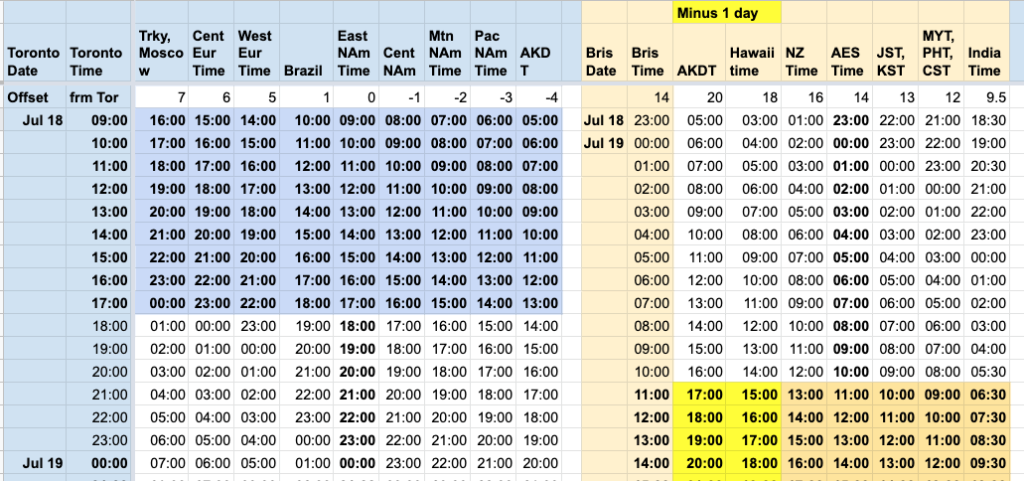 A portion of one of the spreadsheets we used to deal with multiple time zones.
A portion of one of the spreadsheets we used to deal with multiple time zones.
Many volunteers were needed. To successfully run our online conference, we required the help of dozens of additional volunteers in addition to the people on the organizing committee. Volunteers (for whom we are extremely grateful!) were needed to help staff the Help Desk, to stream the videos during the parallel sessions, to monitor the various chat forums, and to help visitors to the poster building figure out how to find the posters they wanted to see. All of the volunteers had to be trained, and we had to assemble huge spreadsheets to organize who was volunteering when (with multiple time zones listed, of course).
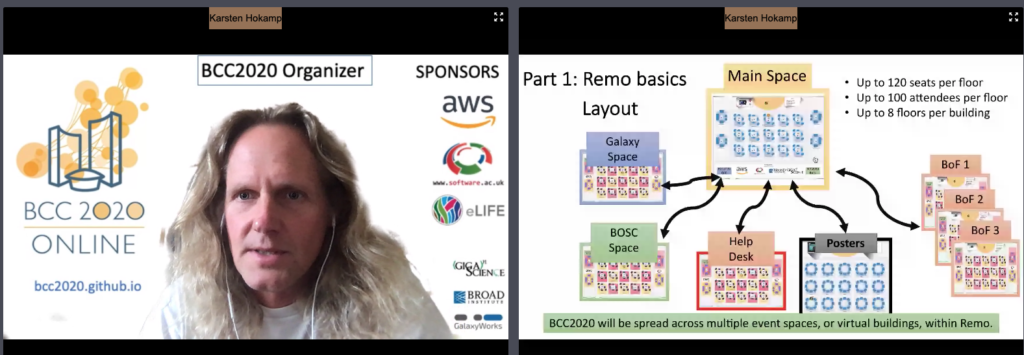 Karsten explaining the BCC2020 setup in Remo during one of the many volunteer training sessions.
Karsten explaining the BCC2020 setup in Remo during one of the many volunteer training sessions.
Stress displacement: during the conference vs. in adva nce. When I plan an in-person meeting, most of the planning happens ahead of time. The meeting itself is somewhat stressful and exhausting, but also a lot of fun (last year, for example, I got to float down the Rhein with a bunch of other conference attendees). There is some pressure on the session chairs, who have to manage the Q&A and make sure speakers don’t go on too long. But the “on-the-ground” stress at an online meeting is so much higher. The session techs (who were responsible for starting each video at the appropriate time) had a particularly nail-biting time of it. (Conversely, the speakers, who had already done the hard work of preparing their talk videos in advance, found the online meeting relatively unstressful.)
Did I mention that planning an online meeting is a lot of work? All in all, I would say that I personally spent about 2x as much time on BCC2020 organizational activities as I do organizing an in-person BOSC–and that’s a substantial amount of time. And that’s just me. Karsten alone probably spent more time on BCC2020 preparation than there are actual hours in the days leading up to the meeting. (But his job in particular would be easier next time if we chose to run another online conference in Remo.)
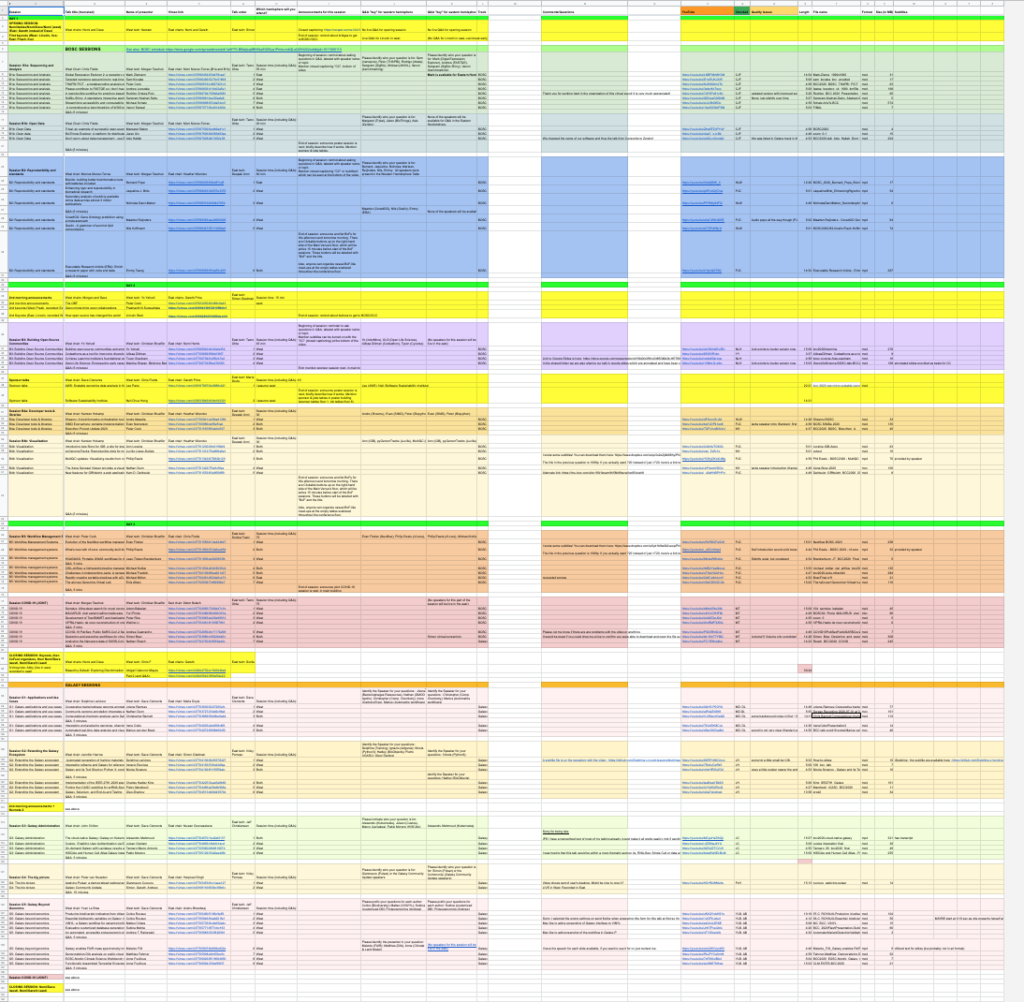 One of many organizational spreadsheets we created to help us keep track of everything. This one (which listed details for each session, including session chair, session tech, talk titles, presenters, talk lengths, video URLs, Q&A times, and more) was nicknamed “the colorful spreadsheet”
One of many organizational spreadsheets we created to help us keep track of everything. This one (which listed details for each session, including session chair, session tech, talk titles, presenters, talk lengths, video URLs, Q&A times, and more) was nicknamed “the colorful spreadsheet”
Why am I going on about how haaaaard it is to plan an online meeting? It’s not because I want praise or sympathy (though those are always appreciated), but because we want to manage expectations for next year’s conference. We know that many people would like us to offer an online conference even if next year’s meeting is physical. Here are a few such comments from the post-conference survey:
“Please make next year’s meeting virtual/hybrid not F2F only.”
“Please keep some aspect of this virtual if it goes back to face-to-face. I may only be able to attend virtually for the foreseeable future. Having this inexpensive option makes this community more accessible and more inclusive.”
“Would really appreciate keeping this conference virtually accessible in the future, at least a hybrid approach maybe!”
So will we make the next BOSC both virtual and in-person? We’ll see what we can do–we sincerely do want to make the conference as accessible and inclusive as possible. But at the same time, there are only so many hours in the day, and all of the organizing committee members have other jobs that pay the rent. If putting on an online conference is 2x the work of an in-person one, running a hybrid event would be 3x as hard, which is simply not feasible. We don’t yet know whether BOSC 2021 will be online or in-person, but whichever it is, we will not be able to support both a full in-person and a full online experience. We hope you understand, and we hope you will join us if you can.
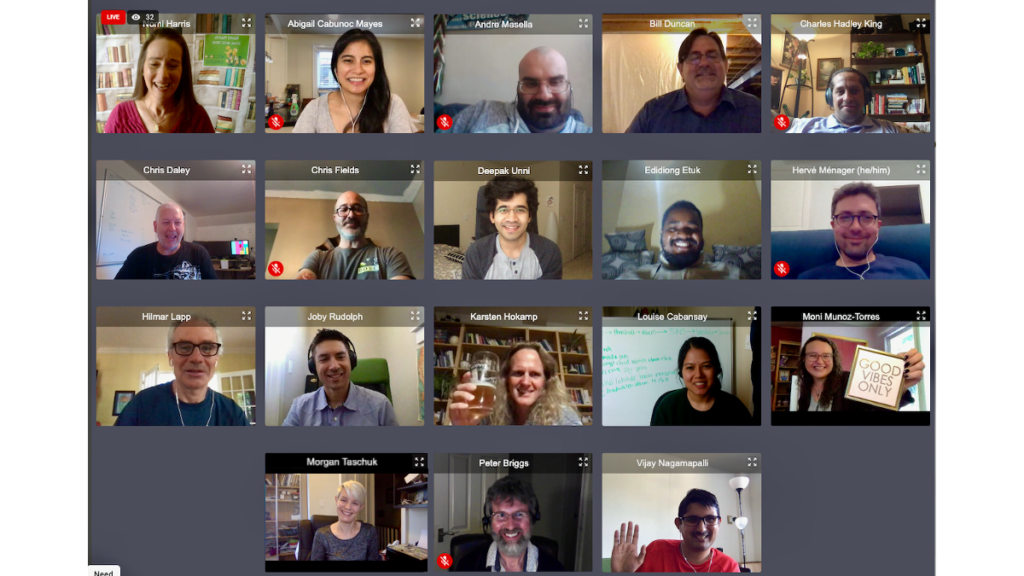 Some of the attendees at the online BOSC party–the next best thing to being there!
Some of the attendees at the online BOSC party–the next best thing to being there!